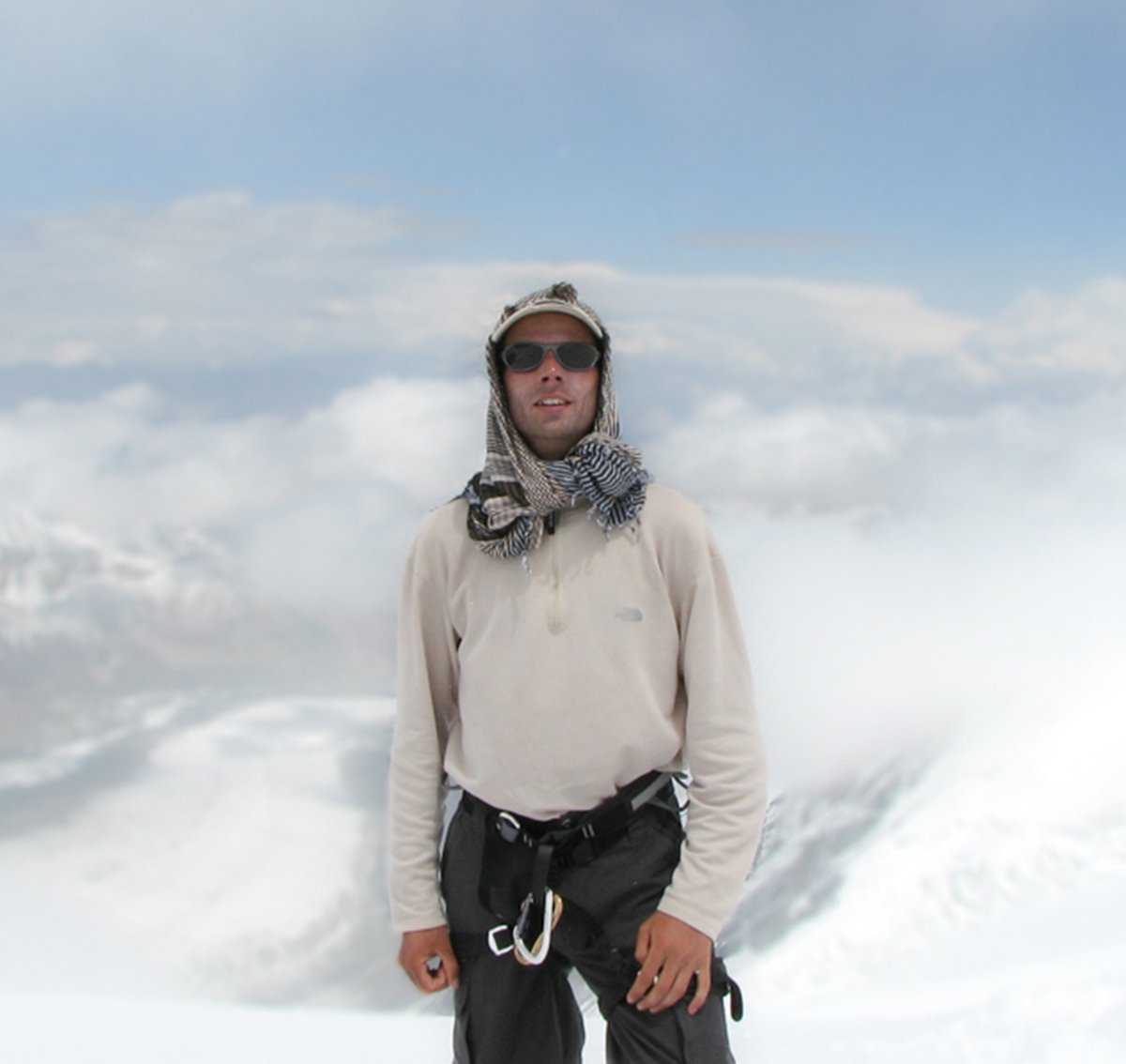
Mt Lenin Summit
I won’t keep you in suspense. I climbed Peak Lenin, 7134 meters to the summit. I’m not sure if that number means anything, so let’s try to put it into perspective. No, it’s not Mount Everest at 8848 meters, but its high, nevertheless. It’s almost a kilometer higher than Mount Denali in Alaska. It’s higher than Kilimanjaro in Africa, Mount Elbrus in Europe and Mount Aconcagua in South America, each of which is the highest on its respective continent. Peak Lenin is the second highest peak in Kyrgyzstan, a small republic in Central Asia, and the third highest in the former Soviet Union. If it were a building it would have approximately 2000 storeys high.
Any mountain over 6000 meters is considered a prize by peak baggers world wide, and in Himalayan countries hefty fees are charged during an attempt on any of those peaks; the higher the peak, the higher the fee. However, there are no peak fees in Kyrgyzstan,which makes it a great place to get some high altitude climbing experience at a reasonable price.
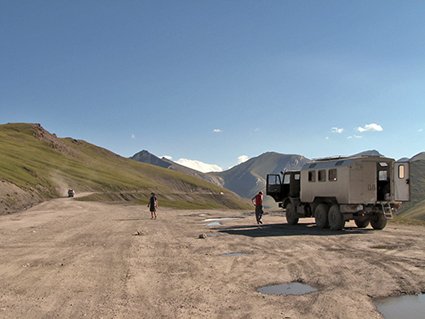 Peak Lenin is considered the easiest 7000-meter peak in the world. There are not a lot of technical hazards on the mountain or technical climbing skills required to summit. Rather, a good level of fitness, determination and patience is needed. Then you must acclimatize properly, which takes several days. And, you need luck. Only 10 – 20% of the 1000 or so people who attempt the climb every year are successful in reaching the summit, and weather is the main reason for failure. It is often cloudy or snowing on the summit and when it isn’t the wind is blowing so hard it is almost impossible to stand.
Peak Lenin is considered the easiest 7000-meter peak in the world. There are not a lot of technical hazards on the mountain or technical climbing skills required to summit. Rather, a good level of fitness, determination and patience is needed. Then you must acclimatize properly, which takes several days. And, you need luck. Only 10 – 20% of the 1000 or so people who attempt the climb every year are successful in reaching the summit, and weather is the main reason for failure. It is often cloudy or snowing on the summit and when it isn’t the wind is blowing so hard it is almost impossible to stand.
It is a nine-hour drive from Bishkek, the second largest metropolis in the country and where I lived, to reach base camp. There are four camps on the mountain with each about 800 meters higher than the previous one. Base camp, where the climb begins, is at 3700 meters. There is electricity, comfy tents, not so smelly outhouses and three meals a day available at base camp, although the size and portion of the meals changes daily. Camp One, or advance base camp is situated at 4500 meters and has the same facilities as base camp except for electricity and the not so smelly outhouse. They should have dug the hole deeper!
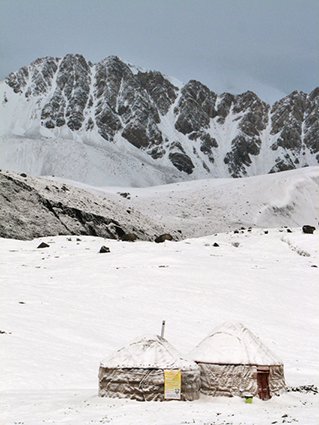 I went with a trekking company that included transportation to and from Osh, and food and accommodations in base camp and camp one. There were several companies offering different services with some offering far more than what I got. For example, one company offered a disco yurt and Internet access at camp one. Another company had beer nights and saunas.
I went with a trekking company that included transportation to and from Osh, and food and accommodations in base camp and camp one. There were several companies offering different services with some offering far more than what I got. For example, one company offered a disco yurt and Internet access at camp one. Another company had beer nights and saunas.
How does one go about climbing a 7000-meter mountain you may ask? The guides told me I should walk to camp one and return, walk to camp two, stay the night and then return to base camp for two nights. Then I should go to camp one and sleep, go to camp two and sleep and then to camp three and sleep before returning to camp one to sleep for two or three nights. I should then be ready for the summit push. To do this, I was to check the weather and if it was favourable for the next three days, I was to go to camp two and sleep, or walk to camp three if strong and return to sleep at camp two. Finally I was to go to camp three and sleep. On summit morning, I was to get up around 4:00 am and start walking no later than 6:00 am. After reaching the summit, I was to return to the lowest camp my strength would permit me to reach.
And how DID I do it? Basically, I did as was suggested by the guides. I had planned to do the climb alone although many people strongly recommended that I not do this. Of course, I didn’t listen, even though the sheer number of warnings was a bit disconcerting.
Nevertheless, I found a climbing partner in base camp, a 31-year old guy from London who was also climbing alone. We both had the same level of experience but Tim wasn’t quite as adventurous as me. He was quite sure we should hire a guide. I refused so we started on our own.
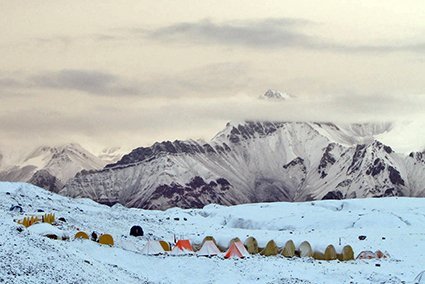 It took us six and a half hours to reach camp one and we were dead tired when we arrived. The next day we rested. Then the weather turned bad and we were stuck in camp for two days. Boredom forced us to attempt to reach camp two in spite of the weather. There was fresh snow and we made it to about 5200 meters. The weather wasn’t too bad but with a 20-kilo pack in snow like sand, my legs decided they weren’t going any farther. We didn’t know how much farther camp two was so we decided to return to camp one. Down hill, this took us just a couple of hours. The next day, due to lethargy, I returned to base camp, uncertain I’d be able to summit.
It took us six and a half hours to reach camp one and we were dead tired when we arrived. The next day we rested. Then the weather turned bad and we were stuck in camp for two days. Boredom forced us to attempt to reach camp two in spite of the weather. There was fresh snow and we made it to about 5200 meters. The weather wasn’t too bad but with a 20-kilo pack in snow like sand, my legs decided they weren’t going any farther. We didn’t know how much farther camp two was so we decided to return to camp one. Down hill, this took us just a couple of hours. The next day, due to lethargy, I returned to base camp, uncertain I’d be able to summit.
I rested for two nights and returned to camp one, shaving about three hours off the trip. The following day, Tim and I flew to camp two (5400 m) with no problems. On our previous attempt we had stopped about an hour from reaching camp two. Still feeling strong the next morning, we reached camp three (6140 m) within five and a half hours. We awoke the following morning with just a slight headache.
It was minus 13ºC inside the tent. Outside the sky was blazing blue and clear and there was no wind. We returned to camp one to continue acclimatizing. A professional Italian climber told us we were crazy to go down when the weather was so perfect. He said most people fail to summit because of “poor summit strategy.” Waiting for good weather in camp three, with its thin air decreased chances of success because the body doesn’t rest properly at that elevation. And, since we didn’t have severe headaches, we should have pushed for the top. We instead, spent three nights in camp one.
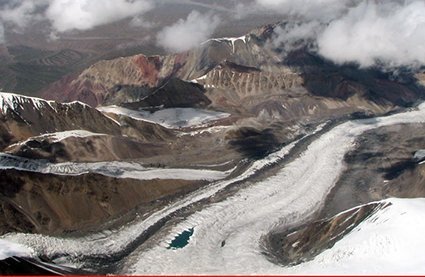
Our time wasn’t wasted. Tim split and hired a guide who could rescue him in the event of bad weather or an accident. I socialized. Gossip is every base camp’s television and pulpit. I learned of one Polish climber who was between camp three and two when he fell and broke his leg. He crawled into his tent until some climbers found him the following morning. They called camp one with details and a rescue was casually, almost grudgingly mounted and the injured man was dragged into camp one. He spent another night in a tent and finally, he was taken by horse to base camp and then by jeep for nine hours to the hospital in Osh. A second climber died when he fell over a kilometer from the summit ridge to camp two. He wasn’t affiliated with any company, so the companies spent a couple of days deciding who would remove the body. Helicopters at this elevation can’t fly because of the thin air so rescue is dubious at the best of times. In short, if anything happens, you are on your own.
It was finally time for me to summit. Being tired, probably from socializing, I made it to camp two and spent the night. The following day, I climbed to camp three in just over three hours. The weather was changing from clear and calm to cloudy, foggy and foreboding. The next morning visibility was a few feet and the wind was strong. As it increased it banged the tent cloth like a drum. Luckily the tent was new. I tried to walk a short distance but the wind knocked me down. The blowing snow sliced my cheeks, stole my breath, frosted my skin. I crawled in my tent and deep into my down bag.
The third morning, I awoke to clear skies but still a howling wind. Should I summit? My head ached. I decided against it but took an aspirin, which made me feel pretty good. However, it was too late now to head up. I rested and psyched myself up for the assault the next morning.
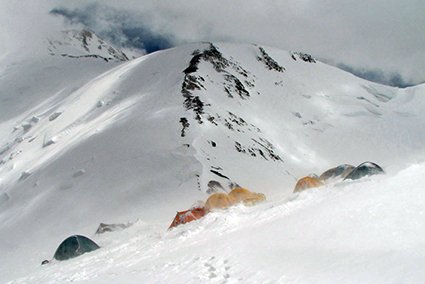 I was up at 3:30 am, with no headache. I had tea and porridge and started up at 4:50 am. I was the first one out but before long, I could see two others behind me. The sky was clear, the wind low. I dropped about a 100 meters before reaching the exposed ridge that led to the top. I was at 6500 meters. As soon as I regained the 100 meters, the wind picked up and continued to do so exponentially with each hundred I gained. It pushed me to my knees. It blew snow that cut my cheeks. It held my breath and I placed my arm over my mouth so I could breath. I was blinded by the white out. My fingers and toes froze in the minus 40ºC temperatures. Then I hit a half-kilometer wide plateau. It was flat but the wind had nothing to block it so it blasted with more force. I couldn’t hide. The sun rose. I trudged two-breaths-one-step. Two-breaths-one-step. On and on. The wind knocked me down again. I struggled up. Two breaths…. I’d trudged for three hours and then I saw a rock! It was like the Holy Grail. I slumped behind it for protection. I was frightened. I had never suffered such wind force before. It could and would defeat me. I hauled myself up and found that the wind had subsided, just a bit. I continued up and up, two breaths, one step. The wind diminished. I couldn’t believe my luck.
I was up at 3:30 am, with no headache. I had tea and porridge and started up at 4:50 am. I was the first one out but before long, I could see two others behind me. The sky was clear, the wind low. I dropped about a 100 meters before reaching the exposed ridge that led to the top. I was at 6500 meters. As soon as I regained the 100 meters, the wind picked up and continued to do so exponentially with each hundred I gained. It pushed me to my knees. It blew snow that cut my cheeks. It held my breath and I placed my arm over my mouth so I could breath. I was blinded by the white out. My fingers and toes froze in the minus 40ºC temperatures. Then I hit a half-kilometer wide plateau. It was flat but the wind had nothing to block it so it blasted with more force. I couldn’t hide. The sun rose. I trudged two-breaths-one-step. Two-breaths-one-step. On and on. The wind knocked me down again. I struggled up. Two breaths…. I’d trudged for three hours and then I saw a rock! It was like the Holy Grail. I slumped behind it for protection. I was frightened. I had never suffered such wind force before. It could and would defeat me. I hauled myself up and found that the wind had subsided, just a bit. I continued up and up, two breaths, one step. The wind diminished. I couldn’t believe my luck.
Then, eight hours and twenty minutes after I left camp, I hit the top of the world where an ocean of peaks glistened below me. I could see Muztagh Ata in China, the Karakoram in Pakistan, the Hindu Kush in Afghanistan and the Pamir in Tajikistan. I could see glaciers and ice and rock and fluffy white clouds. And the wind was resting. I had made the summit of Peak Lenin, at 7134 meters.
